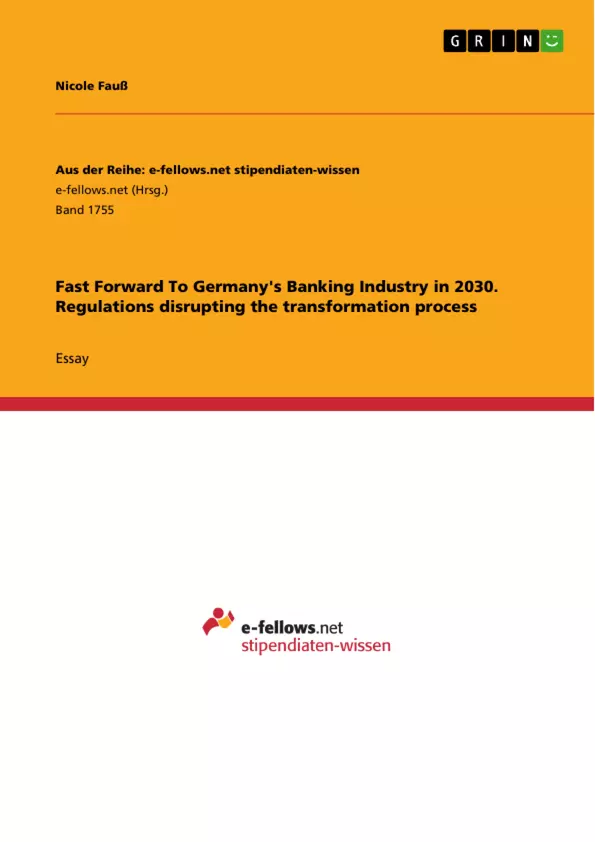The financial crisis of 2008 stopped the deregulation and expansion phase that dominated from the 1990s onwards in Europe’s banking industry. Over the last years significantly changes in the regulatory framework of banking have been made worldwide with the new rules of Basel III, CRD IV, Dodd-Frank and Solvency I to minimize the effect of future crises and protect consumers. Banks worldwide were affected by the increase in regulations, leading to a transformation of the banking industry. Instead of focusing on innovation banks spend large amounts on compliance, reporting and supervisory issues. In 2014 Deutsche Bank, Germans leading bank, spend an additional €1.3 billion on new regulatory requirements. Therefore, the degree of regulations in the future will decide whether banks can transform their business successfully, being able to add value to customers and compete with new competitors.
This essay deals with the transformation process of the German banking industry to 2030.
The essay is divided into four main sections. First it will give an overview of the German banking industry. Then it will outline the major trends and driving forces of the transformation process, followed by the critical uncertainties. The fourth part describes four different scenarios of the German banking industry in 2030 according to the two major critical uncertainties that are the degree of regulations and the type of operating model. In my opinion, a high degree of regulations in combination with a universal operating model is most likely to happen. Therefore, this scenario will be described in more depth. In the end, some conclusions will be derived from the previous scenario analysis on how to survive the transformation process.
Inhaltsverzeichnis (Table of Contents)
- Introduction
- Banking Industry Overview - Germany
- Trends and driving forces influencing the transformation process
- Critical uncertainties
- Scenarios of the German banking industry in 2030
- Scenario analysis
- Conclusions
Zielsetzung und Themenschwerpunkte (Objectives and Key Themes)
This essay examines the transformation process of the German banking industry up to 2030, focusing on the impact of regulations and technological advancements.
- The impact of regulations on the banking industry
- The role of technological breakthroughs in shaping the future of banking
- The evolving competitive landscape, including the rise of FinTech and P2P lending
- The implications of demographic and social changes for banks
- The importance of adapting to changing customer needs and expectations
Zusammenfassung der Kapitel (Chapter Summaries)
The essay begins by providing an overview of the German banking industry, highlighting its structure and key characteristics. It then explores the major trends and driving forces influencing the transformation process, including global economic shifts, demographic changes, and technological advancements. The essay also delves into critical uncertainties, such as the degree of regulations and the type of operating model, and presents four different scenarios for the German banking industry in 2030. Finally, the essay analyzes the most likely scenario and concludes with recommendations for banks to successfully navigate the transformation process.
Schlüsselwörter (Keywords)
The essay focuses on key themes such as the German banking industry, transformation process, regulations, technological breakthroughs, FinTech, P2P lending, demographic changes, customer needs, and operating models.
- Quote paper
- Nicole Fauß (Author), 2015, Fast Forward To Germany's Banking Industry in 2030. Regulations disrupting the transformation process, Munich, GRIN Verlag, https://www.grin.com/document/317333



